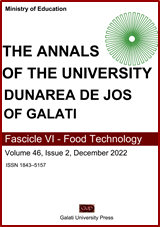Mediterranean diet pyramid of an adult Moroccan population: comparison with the recommendations of the updated Mediterranean diet pyramid
Abstract
One of the illustrations selected for the presentation of the nutritional recommendations of the Mediterranean diet (DM) is the food pyramid (FP). The aim of this work was to design a food pyramid illustrating the dietary pattern of an adult Moroccan population and compare it to the recommendations of the Mediterranean diet pyramid (MDP) updated in 2020 by a group of experts. The study was carried out over the period of 2018 to 2022, on 507 adults from the Rabat-Salé-Kenitra region in Morocco. Socio-demographic data, usability, and toxic habits were collected using a questionnaire. Physical activity was assessed by the Marshal questionnaire. Food intake and food diversity have been determined by food history and food variety by food frequency questionnaires. The majority of the study population was over 34 years old (59%), resides in urban areas (70%), of which women (52%), sufficiently active (57%) and without any toxic habits (99.9%). A proportion of 31% still participate in meal preparation within the household, and 48.9% have at least two meals with the family daily. The population’s energy and protein intakes are higher (p<0.001) while their dietary fiber and water intakes are lower than the recommended intakes (p<0.001). The FP constructed according to the population’s food consumption comprises, from the bottom to the top, 1) water, 2) cereals and starchy foods, 3) sugars and sweet products, 4) fruits and vegetables, 5) dairy products, 6) olive oil, and 7) pulses, dried fruits, red meat, fish, chicken, eggs, and olives. The hierarchy and frequency of the consumption of certain foods and food groups differ from the recommendations of the updated MDP, reflecting a shift from sustainable diet.


